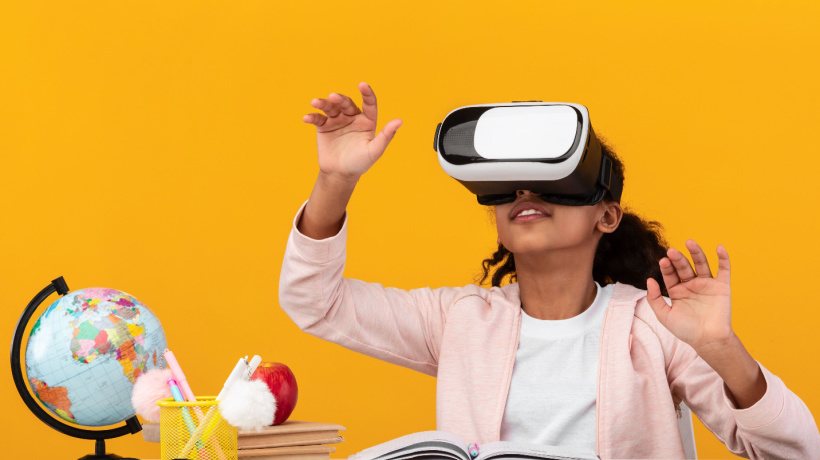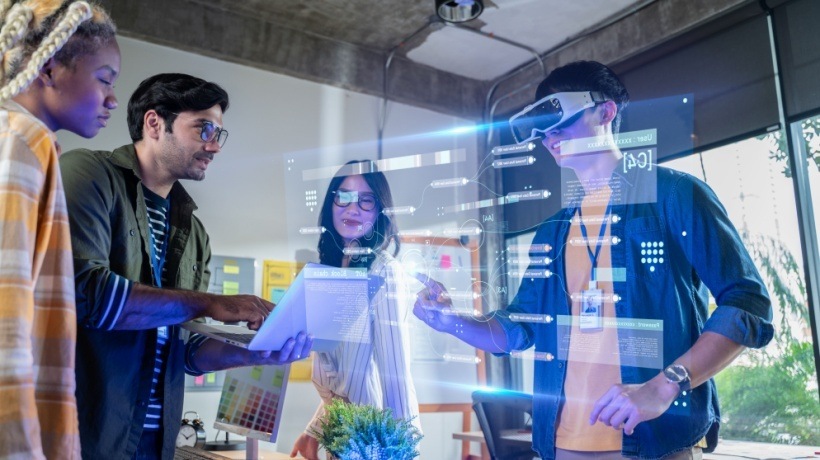The Exciting Potential Of AR And VR In eLearning
In recent years, Augmented Reality (AR) and Virtual Reality (VR) technologies have gained popularity in the education and training industry as effective tools for enhancing the learning experience. With the ability to provide an immersive and interactive learning environment, AR and VR are transforming the way we approach eLearning. In this article, I will discuss the benefits of using AR and VR in eLearning, including enhancing engagement and retention, providing realistic simulations, allowing for remote and flexible learning, and saving time and money. I will also provide examples and statistics from research to support the effectiveness of these technologies. Overall, I believe that AR and VR have the potential to revolutionize the way we approach education and training, providing learners with a more engaging, effective, and cost-efficient learning experience.
How AR And VR Technologies Can Transform eLearning
AR/VR technologies have the potential to revolutionize the way we approach eLearning. Here are some arguments for why AR and VR are effective tools for eLearning, supported by examples and statistics from the research:
1. Enhancing Engagement And Retention
One of the biggest challenges of eLearning is keeping learners engaged and motivated. AR and VR can provide an immersive and interactive learning experience that is more engaging than traditional methods. Research has shown that immersive technologies can improve information retention and recall. For example, a study by the University of Maryland found that participants who learned using VR remembered information better than those who learned through traditional methods.
2. Providing Realistic Simulations
AR and VR can be used to create realistic simulations of real-life scenarios, providing learners with a safe and controlled environment to practice and develop their skills. This can be particularly useful for training in high-risk industries, such as healthcare or aviation. For example, a study by the University of Georgia found that medical students who used a VR simulator for a surgery procedure performed significantly better than those who used traditional methods.
3. Allowing For Remote And Flexible Learning
AR and VR can provide remote and flexible learning opportunities, allowing learners to access training materials and simulations from anywhere in the world. This can be particularly useful in situations where learners are unable to attend in-person training sessions. For example, a study by the University of Southern California found that VR training was effective for teaching surgeons, even when they were located in different parts of the world.
4. Saving Time And Money
AR and VR can be used to create cost-effective and time-efficient training programs. For example, VR can be used to simulate real-world scenarios, reducing the need for expensive equipment or facilities. A study by PwC found that VR training was 4 times faster and 275% more focused than traditional training methods, resulting in cost savings and improved productivity.
From these arguments, we can see that AR/VR technologies could be very useful in corporate education. These technologies can help engage employees in training and development activities, provide realistic simulations and scenarios for learning, and enable remote and flexible learning options. In addition, AR/VR can provide cost-effective solutions for training in high-risk or complex environments, such as manufacturing or healthcare. With the potential to increase engagement, retention, and performance, AR/VR technologies have significant potential to transform corporate education and training.
Real-World Examples Of AR/VR Usage In eLearning
Augmented Reality and Virtual Reality are rapidly changing the way we approach education and training. These technologies offer an immersive and interactive learning experience that can be used in a variety of fields. In this section, I introduce four real-world examples of AR/VR being used in eLearning.
First, I discuss Pearson's VR Nursing Experience, a Virtual Reality simulation designed to help nursing students practice procedures in a safe and controlled environment. Next, I talk about Walmart's VR training program, which uses Virtual Reality simulations to train employees in various departments. Then, I introduce Case Western Reserve University's HoloAnatomy program, which uses Augmented Reality to teach anatomy to medical students. Finally, I discuss Walmart and Verison's AR training program, which uses Augmented Reality to train employees about new technology products.
These examples demonstrate the versatility and potential of AR/VR in eLearning, showing how these technologies can be used in various fields to provide an engaging, effective, and efficient learning experience. Through these innovative applications, AR and VR are revolutionizing the way we approach education and training.
1. Pearson's VR Nursing Experience
Pearson, a leading educational publisher, has developed a VR Nursing Experience that allows nursing students to practice various procedures in a safe and controlled environment. The experience includes simulations of tasks such as wound care, IV insertion, and medication administration. Students can receive feedback and guidance in real time, helping to improve their skills and confidence.
2. Walmart's VR Training Program
Walmart has developed a VR training program that is used to train employees in various departments, including customer service and compliance. The program includes simulations of common scenarios that employees might encounter, such as dealing with a difficult customer or identifying potential hazards in the workplace. The program has been shown to improve employee engagement and retention.
3. Case Western Reserve University's HoloAnatomy
Case Western Reserve University's HoloAnatomy program uses Microsoft HoloLens, an AR headset, to teach anatomy to medical students. The program allows students to view 3D holographic images of the human body, providing a more interactive and immersive learning experience than traditional methods.
4. Walmart And Verison's AR Training Program
Walmart and Verison have partnered to create an AR training program for Walmart employees. The program includes interactive modules that teach employees about new technology products, such as smartphones and smart home devices. Employees can use AR to view 3D models of the products and learn how to use them.
These examples demonstrate how AR/VR can be used to enhance the learning experience in various fields, including healthcare, retail, and technology. As the technology continues to advance, we can expect to see even more innovative uses of AR/VR in eLearning.
Potential Negative Aspects Of These Technologies
However, while AR/VR technologies have many benefits for eLearning, there are also some potential negative aspects to consider. Here are a few:
- Cost
One of the main barriers to implementing AR/VR in eLearning is the cost. Developing high-quality AR/VR content can be expensive, and not all educational institutions or businesses may have the budget to invest in these technologies. - Technical issues
AR/VR technologies can be complex and require advanced technical skills to develop and maintain. Technical issues such as hardware malfunctions or connectivity problems can also disrupt the learning experience. - Health and safety concerns
Extended use of AR/VR can cause health and safety concerns such as headaches, motion sickness, and eye strain. It is important to take breaks and limit exposure to these technologies to prevent such issues. - Limited accessibility
Not all learners may have access to the necessary hardware or internet connection required to use AR/VR technologies, which can limit their ability to participate in eLearning activities that use these tools.
It's important to carefully consider these potential negative aspects and take steps to mitigate them to ensure that AR/VR technologies are used effectively and responsibly in eLearning. It is also difficult to determine whether the negative aspects of AR/VR in eLearning outweigh the positive aspects, as it largely depends on the specific context and implementation of these technologies.
While there are certainly potential negative aspects, such as cost, technical issues, and health concerns, many educational institutions and businesses have found that the benefits of using AR/VR in eLearning outweigh these challenges. These benefits include increased engagement and retention, the ability to provide realistic simulations, and the flexibility to provide remote and flexible learning options. Ultimately, the decision to use AR/VR in eLearning should be based on a careful evaluation of the potential benefits and challenges, as well as the specific needs and goals of the learners and the educational institution or business.
Conclusion
In conclusion, the benefits of using AR and VR technologies in eLearning are clear. From enhancing engagement and retention to providing realistic simulations and allowing for remote and flexible learning, AR and VR offer a range of advantages that can transform the way we approach education and training. With the potential to save time and money, while also improving the quality of the learning experience, it's no surprise that more and more educational institutions and businesses are turning to these technologies.
As research continues to demonstrate the effectiveness of AR and VR in eLearning, it's clear that these tools will play an increasingly important role in the future of education and training. By embracing these technologies, we can create a more engaging, effective, and efficient learning experience for learners across the globe. With the potential to transform the way we approach training and development, it's no surprise that AR and VR are becoming increasingly popular in the eLearning space.
References
- Alzahrani, N. M. 2020. "Augmented Reality: A systematic review of its benefits and challenges in e-learning contexts." Applied Sciences, 10(16), p. 56-60.
- Koh, K., Chapman, O. and Lam, L. 2022. "An Integration of Virtual Reality Into the Design of Authentic Assessments for STEM Learning." In Handbook of research on transformative and innovative pedagogies in education (pp. 18-35). Pennsylvania: IGI Global.
- Mahmud, M. M., Wong, S. F. and Ismail, O. 2022. "Emerging Learning Environments and Technologies Post Covid-19 Pandemic: What’s Next?" Advances in Information, Communication and Cybersecurity: Proceedings of ICI2C’21, pp.308-319.
- Ng, D. T. K. 2022. "What is the metaverse? Definitions, technologies, and the community of inquiry." Australasian Journal of Educational Technology, 38(4), pp. 190-205.
- Shakirova, N., Said, N. and Konyushenko, S. 2020. "The use of Virtual Reality in geo-education." International Journal of Emerging Technologies in Learning (iJET), 15(20), pp.59-70.









